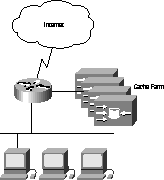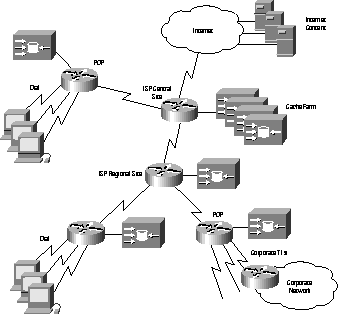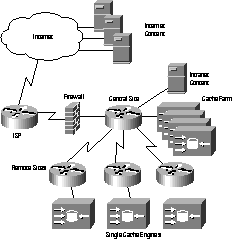




Cisco Cache Engine
Overview
The Cisco Cache Engine performs shared network caching of Web
content to eliminate repeated transmission of identical content over wide-area
network (WAN) links. The solution includes high-performance Cisco
Cache Engines that communicate with Cisco IOS® routers using
the Cisco Web Cache Control Protocol.
WAN Traffic Congestion and the Caching Solution
Companies rely upon Web access for a range of mission-critical business
functions. As a result of the overwhelming growth of Web traffic, network
administrators face the need to spend more money on WAN access bandwidth
and service. Yet, a lot of Web traffic can be redundant---multiple
users at any given site request the same content. With the Cache Engine,
Cisco has seized the opportunity to intelligently reduce bandwidth usage
and improve network response time. The Cache Engine dynamically retrieves,
stores, and serves Web content locally to eliminate redundant Web
traffic and provide faster Web access.
In operation, when a user first requests particular Web content, the
Cache Engine intercepts the request, fetches the Web page from the remote
server, and sends the content to the user while simultaneously storing
the content locally. The system satisfies subsequent requests for the same
content from local storage. The Cache Engine has the built-in intelligence
to determine what can and should be cached. (For example, stock price
data is not cached, but the banners and buttons on the stock quotation
Web page are cached for a configurable period). The Cache Engine
can also dynamically refresh content stored locally. The result is
much higher-performance Web access for the end user, with a significant
reduction in WAN traffic volume.
Features at a Glance
The Cache Engine offers the following features:
-
Transparent to Web browsers---A Cisco IOS router sends all Web traffic---and
only Web traffic (TCP port 80)---to the Cache Engine, without requiring
any changes to client browsers. In this manner, caching is entirely transparent
to the browser (clients do not have to point at any particular cache device
to benefit from Web caching). The end user notices only that Web page access
times improve.
-
Scalable on a system wide basis---Multiple Cache Engines can be installed
to form cache farms. Customers can incrementally add up to 32 Cache Engines
to a cache farm, with each additional engine taking on an even portion
of the network load. Because caching happens in parallel with other
traffic handled by the router, and because each engine takes on an equal
share of the stored Web content, the Cache Engine provides linear scaling
of storage and connections as engines are added. (Two Cache Engines provide
twice the storage and connection capacity of a single Cache Engine.)
-
High performance---The Cisco Cache Engine is a specially designed, dedicated
Internet appliance. It uses special- purpose, thread-oriented software
to achieve extremely high performance. The engine's real-time operating
system avoids the relatively high overhead per process that plagues general-purpose
operating systems.
-
Extensive reporting and logging capabilities---Each Cache Engine provides
detailed reporting and logging capabilities to monitor operation, performance,
usage, and savings. Built-in graphing capabilities are available for hourly,
daily, and monthly historical trending. Local and external logging capabilities
are also available for more comprehensive tracking functions.
-
Fault-tolerant and fail-safe---If any single Cache Engine fails, the Web
Cache Control Protocol reassigns the traffic load among the remaining Cache
Engines. When the failed Cache Engine comes back on line, the system
"heals" itself by intelligently reassigning traffic to the newly functioning
Cache Engine. If all Cache Engines fail, the router sends Web traffic to
the intended remote server just as it did before the Cache Engine
was installed---for true fail-safe operation with no loss of network functionality.
-
Simple to deploy and manage---Installation involves connecting the Cache
Engine to a 10/100-Mbps Ethernet port on the router and executing
a small set of router and Cache Engine configurations commands. All
other Cache Engine configuration options are set using a standard Web-browser
interface. The management for all engines within a farm is accessible
through a single Web interface. In addition, the Web Cache Control Protocol
only needs to run on the router that redirects Web traffic to the Cisco
Cache Engines. Thus, a network-wide Cisco IOS upgrade is not required.
-
Hierarchical deployment---Because the Cache Engine is transparent, customers
can place Cache Engines at several levels in a network hierarchy. Web requests
can be fulfilled from any layer in the hierarchy. Additional Cache hierarchies
can be constructed using the Internet Cache Protocol (ICP).
Benefits
By reducing the amount of traffic on WAN links and on overburdened
Web servers, caching provides significant benefits to service providers,
enterprise networks, and end users.
-
Cost savings due to WAN bandwidth reduction---Service providers can place
Cache Engines at strategic points on their networks to improve response
times and lower the bandwidth usage on their backbones. Service providers
can station Cache Engines at strategic WAN access points to serve
Web requests from a local disk rather than by accessing the (distant or
overrun) Web servers. In enterprise networks, the dramatic reduction in
bandwidth usage due to Web caching would allow a lower-bandwidth
(lower-cost) WAN link to serve the same user base.
-
Improved productivity for end users---The response time of a
local Web cache is much faster than the download time for the same content
over the host site. End users see dramatic improvements in response times,
and the implementation is completely transparent to them.
-
Ease of use---The Cache Engine is designed to be installed in minutes by
even a novice. Only five commands on the Cache Engine are required and
only one command is needed on the accompanying Cisco router for initial
deployment. All subsequent configuration and management tasks can be performed
using any standard Web browser from anywhere within the network.
-
Content control---The Cache Engine provides network administrators with
a simple, secure method to enforce a site wide access policy
through Universal Resource Locator (URL) filtering.
Technology Overview
The Cisco Cache Engine is a robust, high-performance Web cache solution
that provides for ease of deployment and very low cost of ownership.
The system leverages the large installed base of Cisco IOS routers to further
increase the value of enterprise and service provider customers'
investments in Cisco equipment. The system was designed from the ground
up as a loosely coupled, multinode network system optimized to provide
robust, high-performance class, shared-network caching.
The solution comprises the Web Cache Control Protocol (a standard
feature of Cisco IOS software) and one or more Cisco Cache Engines
that store and retrieve cached data locally.
-
The Web Cache Control Protocol defines the communication between Cache
Engines and routers. Using the Web Cache Control Protocol, a router redirects
Web requests to a Cache Engine (rather than to the intended
Web server). The router also determines Cache Engine availability
and redirects requests to new Cache Engines as they are added
to a cache farm.
-
The Cache Engine uses a high-performance file system designed solely for
caching systems, eliminating the file fragmentation and long directory
searches associated with general-purpose file-system software. The Cache
Engine's secure, real time, embedded operating system avoids the
relatively high process context overhead of general- purpose operating
systems. The result is an extremely high-performance, scalable Cache
Engine.
Operation
In operation, a Cisco IOS router sends all Web requests to the
Cache Engine without requiring any changes to client browsers---caching
is entirely transparent. The first time a particular Web page is
requested, the Cache Engine sends the request to the Web server and forwards
the resulting content to the requester while storing the content. All subsequent
requests for the same content are fulfilled by the Cache Engine,
eliminating that traffic from the WAN link. The end user notices
only that Web page access times improve.
Figure 1 shows a solution that incorporates a four-Cache Engine
cache farm. When customers add Cache Engines to scale a cache farm,
each additional engine takes on an equal portion of the stored data.
For example, a single Cache Engine provides 24 GB of storage and 2000 concurrent
sessions; two Cache Engines provide 48 GB of storage and 4000
concurrent sessions. A single cache farm can scale to 32 Cache Engines,
providing 768 GB of cache storage and 64,000 concurrent sessions.
Figure 1: The Cache Engine is connected directly to the router

Applications
Large Web caches are used primarily by service providers and institutions
with hundreds of users, for example, universities, large enterprises, and
Internet gateway sites around the world. Because so much Internet content
is currently located in North America, international institutions use Web
caching to extract maximum benefit from costly transoceanic links. ISPs
can deploy cache farms hierarchically to gain the benefits of caching at
each level of their network infrastructures, as shown in Figure 2.
Figure 2: Deployment of Cache Engine Cache Farms for an ISP

Small and medium-sized businesses and branch offices can use the
Cache Engine to cache Internet and intranet Web servers at both a
central site and remote offices. (See Figure 3.) This hierarchical
implementation reduces congestion at central servers and frees bandwidth
on intersite links.
Figure 3: Enterprise Deployment of Cache Engines

Service and Support Options
Service and support for the Cache Engine are available on a one-time
or annual contract basis. Support ranges from help-desk assistance to proactive,
onsite consultation. All support contracts include major Cisco IOS software
updates, full access rights to Cisco Connection Online, and 24-hour-a-day
technical assistance. Contact your local sales office for further
information.
Availability and Orderability
The Cache Engine is generally availability. Table 1 lists orderable products
of the Cache Engine:
Table 1: Cache Engine Products
| Product Number |
Product Description |
| Cache Engine CE2050 |
24-GB/2000-session Cache Engine |

Posted: Thu Oct 15 07:44:44 PDT 1998
All contents copyright © 1992--1998 Cisco Systems,
Inc. Important Notices.


